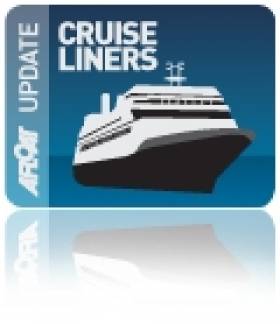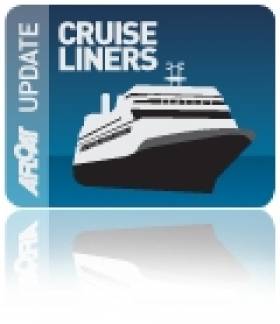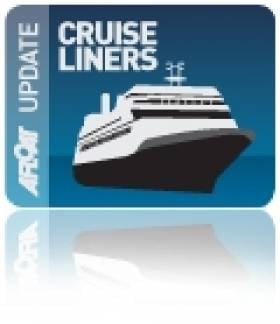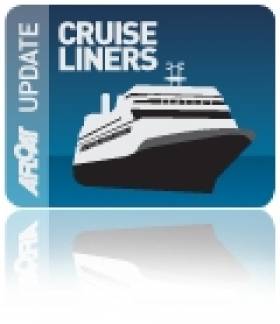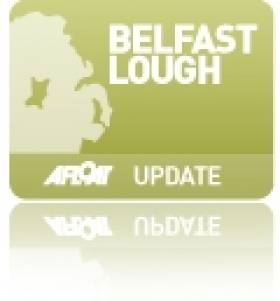Displaying items by tag: Royal Princess
#PortRecordBroken- Dublin Port has again broken its own record this month as the largest ever ship to dock Royal Princess called this morning which saw the massive 142,000 tonnes cruiseship surpass previous title holder MSC Splendida, writes Jehan Ashmore.
Royal Princess towering all 19 decks is the largest cruiseship (in terms of gross tonnage) to visit Dublin Port. She had cancelled a second call off Dun Laoghaire Harbour as previously reported for today and where the Princess Cruises ship instead is on her maiden call to the capital's port.
It is only a fortnight ago since the 137,000 tonnes MSC Splendida (18 decks) made maritime history in Dublin Port as the largest vessel of any type to berth albeit in reverse! She subsequently made a repeat call on Thursday just gone.
The French built MSC Splendida with 3,200 passenger (600 more on the Royal) capacity cruiseship still holds the port's record for longest cruiseship at 333m but by only 3m more than Royal Princess which too required 'reversing' astern. This was due to the confines of the turning circle that prevented conventional berthing leading into Alexandra Basin West.
Such skilful berthing procedures by going astern required pilots in advance to undergo simulator exercises in the National Maritime College of Ireland (NMCI) Ringaskiddy, Cork.
This involved a rendez-vous in central Dublin Bay as the 'Royal' approched the shipping channel and was turned by port sister tugs, one stationed off the bow, the other within feet of the transom. Also astern the cutter Camac having earlier dispatched a pilot on board the first Princess Cruises ship to exceed 1,000ft long.
To give an indication of the sheer size of Royal Princess she is 330m long, 44m (155ft) in width and draws a draught of 8.5m (28ft) same as 'Splendida'.
Having seen both massive cruiseships in Alexandra Basin West (at same berth), overall MSC Splendida seems more impressive due to her more angular stern and given she is 6m wider on the beam than Royal Princess. She has a much shorter fo'c'slle, i.e. the distance between the bridge and the bow whereas Splendida has a more graceful pronounced prow.
The Royal Princess is some 100,000 tonnes larger to her namesake predecessor which called to Dublin Port during the early 1990's. That 1984 built Royal Princess was 44,000 tonnes and one of the largest cruiseships to have docked in Dublin Port in which I was able to make a port visit and was highly impressed of the ship completed in a Finnish shipyard.
She was pioneering in that she had many cabins fitted with balconies which was trend-setting then yet now is expected on so many cruiseships.
It was not until 2004 that the port's milestone of 100,000 tonnes was broken as previously reported by the same operator's Grand Princess which really launched the benchmark and has ever since as the leadship 'Grand' class became the most frequent and largest cruiseships to call. Royal Princess design origins are a continued evolution of the 'Grand' class.
The first 'Royal' (not a 'Grand' class) was christened by the late Diana, Princess of Wales, noting Catherine, Duchess of Cambridge likewise named the current 2013 built cruiseship.
On board Features of Royal Princess
So what's onboard Royal Princess, the largest ever passenger ship built in Italy which was launched from the Cantieri Navalli Italiani yard in Malfalcone. To start off with she has a two-deck high Princess Theatre located forward with seating for 925 and all with unobstructed sight lines.
Keeping to the theme of entertainment, there's also an on board passenger participation T.V. Studio broadcasting programmes almost all-day. The broadcast can also be watched live in all 1,780 cabins of which 81% feature private balconies.
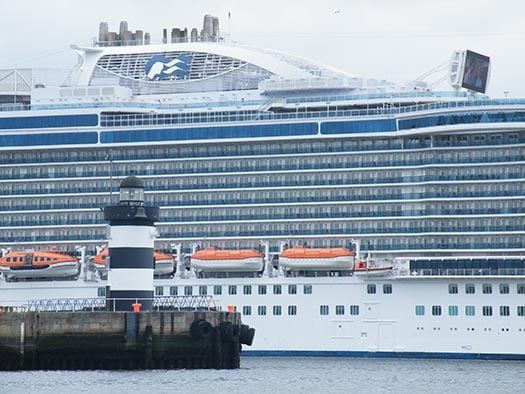
The massive cruiseship's 19 decks tower above Alexandra Basin's lighthouse: Photo: Jehan Ashmore
At that percentage, that figure is very high proportion given this mass-market ship is where Princess Cruises are offering to promote as many cabins with balconies as possible.
The social focus of Royal Princess is centred on the Piazza, a three-deck high atrium located appropriately amidships which is 50% larger than other fleetmates and boasts panoramic lifts, sweeping staircases that start from a marble floor. Also located at the ships main meeting point is the no doubt popular gelateria serving ice-creams and a seafood outlet.
Decks 5-7 is where all the main public facilities are and where three 600-seater main dining rooms are located. In addition to the operators customary Sabatini Italian Restaurent seating 120, Alfredo's Restaurant and Wheeler's Bar.
Above the passenger decks are 7 cabin decks and the top three alone cater for sporting activities where there is an adult-only pool, while teenagers have their own space. What is open to all is the SeaWalk, a cantilevered walkway on Deck 16 which juts 28ft out from the amidships superstructure.
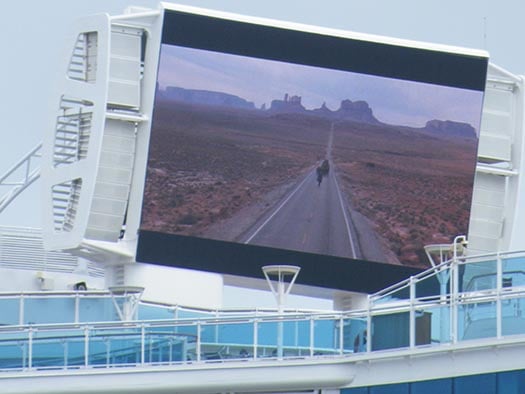
'Route 66' on board the biggest at sea film HD screen 34ft x 20ft. Photo: Jehan Ashmore
This vertigo-inducing feature forms part of the same deck's main outdoor pool where in the evening there is a water and light show. Also located here is the largest at sea HD screen, which runs films from the giant 34ft X 20ft screen.
Royal Princess notably has a far more graceful stern than Spledida. The decks are terraced and are also in complete contrast to the 'Grand'-class as previously reported which came complete with a seemingly precarious aft-mounted Skywalker's Nightclub overlooking the stern.
The cruiseship is scheduled to depart at 7pm.
#RoyalVisitor – Royal Princess at a commanding 142,000 tonnes is even larger than yesterday's Dublin Port record caller MSC Splendida, as this morning's latest caller made her maiden call off Dun Laoghaire Harbour by anchoring in Dublin Bay, writes Jehan Ashmore.
The 19 deck cruiseship christened by Catherine, Duchess of Cambridge almost two years ago at her UK homeport of Southampton had yesterday called to Cobh. This is where her sister Regal Princess was the first caller to dock last month after completion of phase one of Cobh's upgraded deepwater berth.She also became Belfast's biggest caller last year.
The work at Cobh Cruise Terminal is designed to accept RCI's mega sized 'Quantum' class 168,000 tonnes giants with almost 5,000 passengers in which the Port of Cork hope to attract in 2017.
It is the depth of water that restricts Royal Princess drawing 8.5 metres and those such as the 'Quantum' class from entering Dun Laoghaire Harbour.
The Dun Laoghaire Harbour Company have proposed a €18m single cruise-berth jetty as part of a 'masterplan'. The jetty would jutt out 435m and almost be in the centre of the south Dublin Bay port. The plans have been met with mixed reaction and in which An Bord Pleanala will review the planning application along with an Enviromental Impact Statement (EIS).
A similar process applies to Dublin Port Company's proposed €30m double-berth cruise terminal to enable much larger callers to dock closer to the city-centre.
As for the length of these 'next generation' cruiseships, MSC Splendida's 333 metres is a Dublin Port record and also pips the Royal newcomer by a mere 3 metres.
In the meantime Royal Princess launches the first of record 21 cruise callers this season to Dun Laoghaire bringing around 100,000 passengers and crew.
She had approached Dublin Bay from offshore via the Kish Lighthouse and North Burford before anchoring over a nautical mile of the harbour's East Pier, which offer some of the best vantage points as does Sandycove and Bulloch Harbour, Dalkey.
Royal Princess is deemed as one of the "Most Popular Ships at Sea" according to Cruise Critic and has already won five prestigious Travel Weekly Magellan Awards in the Large Ship, Atrium, Spa, Pool and Mobile App Design categories. A notably feature is the innovative SeaWalk which being hailed as one of the "Top Gee-Whiz Features at Sea" by USA Today!
Situated on top deck is the largest pool ever featured with Princess Cruises and an enhanced Movies Under the Stars screen. Those seeking a dizzying thrill, there's the aforementioned SeaWalk's of all 128 feet high offering a straight down vertical view!
Several decks below at the bow is where during this morning's anchorage procedures, a special Princess Cruises 50th anniversary flag was raised at the prow of the massive cruiseship.
As for another example of the ships dimensions, she has a breadth of 44 metres, that's four times that of the Naval Service CPV L.E. Orla (P41), a former Royal Navy coastal patrol vessel.
Her naval homeport of Haulbowline facing Cobh is where MSC Splendida today made her maiden call to Cork Harbour. She is one of the largest to visit Cobh noting the biggest albeit 'liner' status of Cunard's QM2 has called in more recent years. She made her Dun Laoghaire debut in 2013.
So when it comes to who is the Irish 'King' of the cruise crown title, this rests with RCI's Independence of the Seas of a whopping 154,000 tonnes which made her debut to Cobh in 2007.
Returning to the former Royal Navy CPV named HMS Swift she served the Hong Kong Patrol Squadron until transfer to the Naval Service in 1988. The CPV visited Southampton's neighbouring port of Portsmouth in 2013 where the RN's base nd HQ are located. Again the same year Royal Princess was commissioned into service to serve the expanding UK cruise market.
#dlharbour – The 1083–foot Royal Princess Cruise Liner that anchored in Scotsman's Bay was welcomed at Dun Laoghaire Harbour on schedule this morning, just after 6am. It is the first cruise ship of the season to arrive at Dun Laoghaire and had sailed overnight from Cork Harbour into the Bay. It will remain off Dun Laoghaire Harbour all day, departing at 6pm.
No sooner had the 217–foot high Royal Princess dropped anchor approximately one kilometre east of Dun Laoghaire's East Pier lighhouse than the ship began disembarking some of its 5,000 passengers and crew by tender at 0630 hours.
Just before 7am the first two orange coloured tenders reached the harbour mouth escorted by a RIB flying a yellow flag.
A welcome programme for the Royal Princess will be staged in the seaside town today aimed at increasing visitor interest in Dun Laoghaire, a Dublin suburb located 13km (8miles) south-east of the City Centre.
2015 is set to be the most successful cruise season for Dun Laoghaire, with an expected 100,000 passengers and crew expected to arrive into the Harbour over the next five months. A total of 21 calls will be made to Dun Laoghaire Harbour, with many of the ships involved bringing in more than 5,000 passengers and crew. The Royal Princess is a brand new next generation vessel and was launched in 2013.
This morning's Dun Laoghaire visit follows yesterday's one day stop-over of the MSC Splendida into Dublin Port, the biggest ship ever to visit the city centre.
#dlharbour – Dun Laoghaire Harbour will receive its first cruise ship of the season at 6am tomorrow (Tuesday, 12th May) with the arrival of the Royal Princess voyaing up from Cork Harbour. It will remain in the Harbour for 12 hours before departing.
The Royal Princess was launched in 2013 and has a cruise / staff capacity of over 5,000 people. It is a new generation cruise ship and has the following dimensions:
Tonnage: 141,000
Length: 1,083 feet
Height: 217 feet
Last week the Dunlaoghaire Cruise Stakeholder Group – comprising the Harbour Company, Council and business stakeholders – launched a welcome programme which will be staged each day of a cruise call. The programme is aimed at increasing visitor interest in Dun Laoghaire and the wider hinterland.
Royal Princess Makes Maiden Calls from North to South
#RoyalPrincess – Following the maiden call of Royal Princess to Belfast, Royal Princess also made a first time visit to Cork Harbour today with the Princess Cruises giant of 141,000 tonnes berthing alongside in Cobh, writes Jehan Ashmore.
She is the third cruise ship making a maiden call this season to Cobh.
At 19 decks high, Royal Princess can carry 3,500 passengers and 1,500 crew. The Italian built vessel launched last year is 330m in length and is over 3 times the length of Thomond Park.
This is the size and style of ship that the Port of Cork Company intend to continue attracting to Cobh's deepwater cruise berth.
Of Cobh's cruiseship customers, the newcomer despite her impressive size is not the largest as Independence of the Seas is some 154,000 tonnes and handles even more cruise-goers totalling 4,300.
The Royal Caribbean International (RCI) 'Freedom' class ship has been a regular caller in recent years.
Around 108,000 passengers on board 54 cruiseships and some 30,000 crew are to generate this season an economic windfall of around €15m to the local economy.
Cobh has been visited by increasingly larger and efficient vessels. Already scheduled for the 2015 season are 15 vessels of a similar size to Royal Princess.
Another trend is the developing demand for turn-around calls and overnight stays. Combine these factors and this has led to the port to commit plans to invest with an upgrading of the current facilities.
Royal Princess: Belfast Cruise Boom Boosted By Biggest Ever Cruiseship Caller
#RoyalPrincess - Belfast Harbour's booming cruise season reached a highlight today as the largest ever cruiseship to visit the northern port docked, the 141,000 tonnes giant Royal Princess, writes Jehan Ashmore.
The 19 decks of the 3,560 passengers/1,500 crew cruiseship towers above Stormont Wharf where she berthed having sailed from Greenock in Scotland.
She is 330m (1,087ft) long by 44m (217ft) wide and was built by Fincantieri in, Monfalcone, Italy. Last year her she was christened by the Duchess of Cambridge at a ceremony held in Southampton.
The cruiseship has 1,780 cabins in which 1,438 with balcony (all outside staterooms feature a balcony).
Amongst her many luxurious facilities, she features the largest top deck pool ever with a Princess Watercolor Fantasy, an enhanced Movies Under the Stars screen, and a SeaWalk with vertigo inducing views for some, involving a drop of 128 foot looking straight down!
Compared to other fleetmates, she has a larger and expanded atrium with additional entertainment and casual dining options.
The visit of Royal Princess is one of more than 60 cruiseship callers this season in which Cruise Belfast, a marketing partnership between Visit Belfast and Belfast Harbour are promoting the sector which expects a total of 110,000 passengers by the end of October.
Asides todays call of Princess Cruises other large cruiseship operators have made Belfast a port of destination on their itinerary this season attracted by what the city and province has to offer. Leading operators have been Royal Caribbean International, MSC Cruises and Holland America Line.
A sister, Regal Princess entered service in May of this year and a third newbuild, Britannia which will operate for owners Carnival Corporation, through their UK brand P&O Cruises will be launched into service in 2015.
As previously reported, Britannia is to make her debut season with an anchorage call off Dun Laoghaire Harbour next July. She will be the largest ever cruiseship built exclusively to serve the UK market.
#CruiseBelfast- Belfast Harbour's bumper cruise season is to have a total of 61 callers this year, among them the largest cruiseship ever to visit the port, the newbuild Royal Princess which has a capacity of 3,600 passengers, writes Jehan Ashmore.
The 141,000 tonnes Princess Cruises ship has 1,780 cabins and a crew of 1,300 and she is to arrive on 18 September. She is one of several large cruise callers attracted to Belfast because of the various attractive tourism options to offer cruise-operators.
At the other end of the cruiseship scale at under 10,000 tonnes is the prestigious Seabourn Legend which is visiting Belfast today. She is on her final cruise of Irish & UK ports for Seabourn Cruises and as previously reported she called to Dun Laoghaire yesterday.
Cruise Belfast, a marketing partnership between Visit Belfast and Belfast Harbour is expected to generate a total of 110,000 passengers and crew to visit the city by the end of October. The partnership is also to attract to the city major stop-over calls of the travel itineraries operated by the world's leading cruiseship companies.
The boost to Belfast fortunes is reflected in that the harbour as an international desination is outperforming other key UK port-cities among them Liverpool and Glasgow. In addition Belfast is now ranked as the second most popular cruise city on the island of Ireland with only Dublin surpassing in cruise visitor numbers.



























